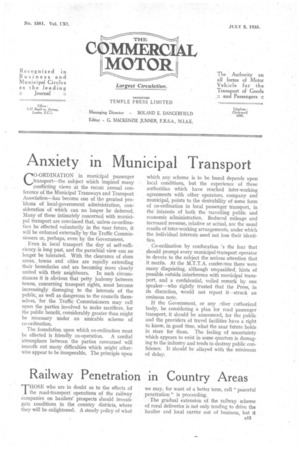Railway Penetration in Country Areas THOSE who are in doubt
Page 23

Page 24

If you've noticed an error in this article please click here to report it so we can fix it.
as to the effects of .1 the road-transport operations of the railway companies on hauliers' prospects should investigate conditions in the country districts, where they will be enlightened. A steady policy of what we may, for want of a better term, call "peaceful penetration" is proceeding. The gradual extension of the railway scheme of rural deliveries is not only tending to drive the haulier and local carrier out of business, but it 1313 is actually putting the farmers in a position in which they are utterly dependent on the railways.
An extraordinary instance which, nevertheless, serves unquestionably to prove this occurred during the heavy snowfalls which came during May. It had hitherto been the custom for country surveyors to clear the roads of snow by means of snow ploughs kept in readiness near places where the snow is apt to drift. As motive power, the horses of local farmers were formerly requisitioned. This year, on approaching the farmer, it was disclosed that horses were not available ; the farming community in the r fea in question had sold all those animals they used to keep for road transport, preferring to make use of the railway company's aid.
Under the 1933 Act, the railways appear to be able to acquire licences for road vehicles on the plea that additional tonnage is necessary for them if they are efficiently to carry out their legal obligations. The road haulier has no such legal justification. It needs no great flair for prognostication to envisage the time when the railways, having acquired sufficient vehicles to handle all the available traffic, will be able successfully to appeal against the grant of licences to anyone else.
Difficulties with Stearn-vehicle Markings
I T is known that the Ministry of Transport is undertaking the consolidation of the Regulations concerning the construction and use of motor vehicles, and the Minister has promised to give consideration to the amending Of the Regulations in connection with the marking of the maximum permitted speeds •on steam vehicles, difficulties regarding which have been brought to his notice by the Commercial Motor Users Association.
Regulation 10 of the 1931 Regulations provides that in a heavy steam four-wheeler registered before January 1, 1932, the maximum weight may be 14 tons if the maximum speed is 12 m.p.h, The 1934 Act provides that the maximum speed for a heavy motorcar without trailer shall be 20 m.p.h., the weight limit being 12 tons; whilst Regulation 38 of 1931 requires that the maximum speed of the vehicle alone must be marked on it.
Operators who desire to comply with the requirements are, in some cases, being prosecuted (a) if the marking show 20 m.p.h. in a case where advantage is taken of loading up to 14 tons, when the police claim that the marking should be 12 m.p.h. ; (b) if the marking be 12 m.p.h., but where, because the load does not exceed 12 tons, the vehicle is driven at 20 m.p.h., because the police state that the proper marking is then 20 m.p.h.
The difficulty does not occur in connection with a steam vehicle registered on or after January 1, 1932, because it may weigh 13 tons and travel at 20 m.p.h.
Uniform instructions are, however, required to enable operators to mark their vehicles so as to avoid the liability to prosecution, whilst taking advantage of the alternative loadings, subject to compliance with the appropriate speed limit of either 12 m.p.h. or 20 m.p.h. In the meantime, the Secretary of State, in consultation with the Minister of Transport, has sent a circular to chief officers of police explaining what appears to be the correct position.




















































































